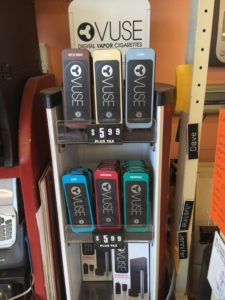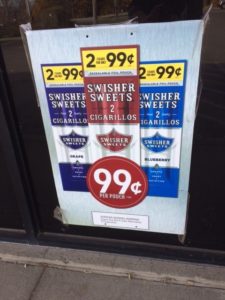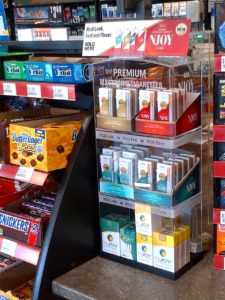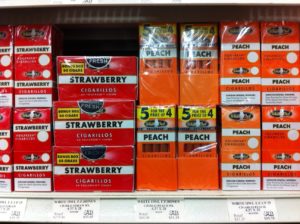Welcome to CounterTobacco.org’s “News and Research Roundup!” Each month we post a summary of the latest research, reports, and news stories on counteracting tobacco product sales and marketing at the point of sale (POS). Keeping up with what’s happening in the POS movement all across the country can help you choose policies and strategies that work best for your community. New research can help provide support for your work and evidence for the importance of the “War in the Store.” Have a story you don’t want us to miss? E-mail it to us!
New Research
Tobacco Retailer Density
- Tobacco retail licensing and density 3 years after license regulations in Philadelphia, Pennsylvania (2012-2019), American Journal of Public Health
- Researchers evaluated the effects of implementation of tobacco retailer licenses on density of tobacco retailers in Philadelphia, Pennsylvania. They found that, three years after implementation, the density of tobacco retailers declined by a little over 20%, with a 12% decline in the rate of retailers within 500 feet of schools. The reduction in tobacco retailer density was significantly greater in low-income districts compared to “not-low-income” districts. These findings suggest that tobacco retailer licenses can effectively reduce tobacco retailer density, income-based disparities, and rates of tobacco retailers near schools. Learn more about licensing and tobacco retailer density.
- News story: More stringent regulations are reducing tobacco retailers in Philly, study finds, Philly Voice
Mint, Menthol and Other Flavors
- Impact of flavoured tobacco restriction policies on flavoured product availability in Massachusetts, Tobacco Control
- This study assessed differences in the availability of flavored tobacco products between communities in Massachusetts that enacted flavor restriction policies and those that did not. In communities that implemented
 flavor restrictions, the reduction in flavor product availability ranged from 27%-61% from pre- to post-policy implementation; communities that had not passed a policy remained stable in flavored product availability over the course of the study period. These findings suggest that the policy was effective in reducing the availability of flavored products. Also, regardless of community demographics and retail characteristics, compliance with flavor restrictions was high. Learn more about flavored tobacco products at the point of sale.
flavor restrictions, the reduction in flavor product availability ranged from 27%-61% from pre- to post-policy implementation; communities that had not passed a policy remained stable in flavored product availability over the course of the study period. These findings suggest that the policy was effective in reducing the availability of flavored products. Also, regardless of community demographics and retail characteristics, compliance with flavor restrictions was high. Learn more about flavored tobacco products at the point of sale.
- This study assessed differences in the availability of flavored tobacco products between communities in Massachusetts that enacted flavor restriction policies and those that did not. In communities that implemented
E-Cigarettes
- Association of electronic cigarette regulations with electronic cigarette use among adults in the United States, JAMA Network Open
- In this cross-sectional study of nearly 900,000 US adults, researchers assessed the association between various e-cigarette regulations and current e-cigarette use. They found that the odds of current e-cigarette use were significantly lower in states that required retailer licenses to sell e-cigarettes, prohibited the sale of all tobacco products to those under age 21, and taxed e-cigarettes. This study suggests that various state regulations regarding e-cigarettes may influence, and ultimately reduce, e-cigarette use. Learn more about licensing and e-cigarettes at the point of sale.
- News story: State laws linked to reduced adult e-cigarette use, HCP Live
- Exposure to secondhand aerosol from electronic cigarettes among US youth from 2015 to 2018, JAMA Pediatrics
- Secondhand aerosol from e-cigarettes is not harmless, given it contains nicotine and other potentially toxic substances. As well, the authors indicate that exposure to secondhand aerosols from e-cigarettes could lead to increased curiosity about e-cigarettes and heightened susceptibility to tobacco products. Using data from over 75,000 respondents to the National Youth Tobacco Survey, the researchers found that, among respondents from 2018 who never used tobacco, students who reported secondhand aerosol exposure compared to those reporting no exposure had 1.9 times the odds of susceptibility to e-cigarettes and 1.6 times the odds of susceptibility to cigarettes. Learn more about e-cigarettes.
- What are the reasons that smokers reject ENDS? A national probability survey of U.S. adult smokers, 2017-2018, Drug and Alcohol Dependence
- In this study, researchers assessed the reasons smokers discontinued or chose not to use electronic nicotine delivery systems [ENDS]. Data was gathered from a probability sample of nearly 2,000 US adults who were current smokers but who did not currently or had never used ENDS. The primary reported reasons respondents stopped using ENDS were that they felt using ENDS did not feel enough like smoking, had only tried ENDS to see what the products were like, and found ENDS did not help with smoking cravings. Nearly 40% of the respondents stated they had never tried ENDS; the primary reported reasons for not trying ENDS were avoidance of substituting one addiction for another, concerns
 about safety, skepticism about ENDS’ assistance with quitting, and cost. Learn more about e-cigarettes at the point of sale.
about safety, skepticism about ENDS’ assistance with quitting, and cost. Learn more about e-cigarettes at the point of sale. - News story: Cigarette smokers often reject electronic cigarettes, Georgia State study shows, GSU News Hub
- In this study, researchers assessed the reasons smokers discontinued or chose not to use electronic nicotine delivery systems [ENDS]. Data was gathered from a probability sample of nearly 2,000 US adults who were current smokers but who did not currently or had never used ENDS. The primary reported reasons respondents stopped using ENDS were that they felt using ENDS did not feel enough like smoking, had only tried ENDS to see what the products were like, and found ENDS did not help with smoking cravings. Nearly 40% of the respondents stated they had never tried ENDS; the primary reported reasons for not trying ENDS were avoidance of substituting one addiction for another, concerns
- Prevalence of electronic cigarette use among adolescents in New Jersey and association with social factors, JAMA Network Open
- Examination of data from the 2018 New Jersey Youth Tobacco Survey found that questions assessing e-cigarette use that specifically included the mention of Juul products yielded a higher prevalence of e-cigarette use in high school students than when questions either asked only about e-cigarette use or only about Juul use; these findings suggest that some high school students might not consider or might not be aware that Juul devices are e-cigarettes, which has the potential to skew data analysis. The research also found that current e-cigarette use had a significant positive association with current use of other tobacco products, endorsement of a tobacco brand on social media, and possession of tobacco-branded merchandise; a significant positive association was also found with current users who had seen Juul devices being used on school property and had close friends who used Juul devices. Learn more about e-cigarettes at the point of sale.
- News story: Rutgers researchers find e-cigarette use among teens to be higher than previously thought, Onco’Zine
Point of Sale Advertising and Marketing
- Neighborhood disparities in the availability, advertising, promotion and youth appeal of little cigars and cigarillos, United States, 2015, Nicotine & Tobacco Research
- Through a nationally representative sample of audits of over 2,000 cigarette retailers, researchers assessed the availability and marketing of little cigars and cigarillos (LCCs) at the point of sale. They
 found that nearly 90% of stores that were assessed sold LCCs, with 83% selling flavored LCCs and 31% marketing LCCs to youth. They also determined that, compared to neighborhoods with the lowest proportion of Black residents, neighborhoods with the highest proportion of Black residents had 2.24 times the odds of LCC availability, 2.84 times the odds of exterior advertisements, 1.62 times the odds of price promotions, and 1.49 times the odds of youth appeal. Lower income neighborhoods, compared to the highest income neighborhoods, also had greater availability of flavored LCCs, exterior advertising, and youth appeal. Learn more about disparities in point-of-sale advertising and marketing.
found that nearly 90% of stores that were assessed sold LCCs, with 83% selling flavored LCCs and 31% marketing LCCs to youth. They also determined that, compared to neighborhoods with the lowest proportion of Black residents, neighborhoods with the highest proportion of Black residents had 2.24 times the odds of LCC availability, 2.84 times the odds of exterior advertisements, 1.62 times the odds of price promotions, and 1.49 times the odds of youth appeal. Lower income neighborhoods, compared to the highest income neighborhoods, also had greater availability of flavored LCCs, exterior advertising, and youth appeal. Learn more about disparities in point-of-sale advertising and marketing.
- Through a nationally representative sample of audits of over 2,000 cigarette retailers, researchers assessed the availability and marketing of little cigars and cigarillos (LCCs) at the point of sale. They
International
- Factors that influence smokers’ and ex-smokers’ use of IQOS: a qualitative study of IQOS users and ex-users in the UK, Tobacco Control
- This qualitative study of current and ex-smokers in the UK assessed reasons for continued and discontinued use of the iQOS product. They determined six main reasons for initiation and continued use of the product: health (desire to quit smoking and perception of reduced harm), financial (cheaper long-term than combustible cigarette usage), physical (discrete, clean, less odor, similar tactile experience to combustible cigarettes), practical (ability to smoke in smoke-free places), psychological (similar routine as smoking combustibles) and social (improved social interactions). Barriers to use of iQOS included high start-up costs, reduced satisfaction, and maintenance issues. Of note, participants reported beliefs in reduced harm of iQOS due to “less alarming” health warnings and lack of graphic health warnings. Learn more about iQOS.
- The impact of the point of sale tobacco display ban on young people in Scotland: Before and after study, Public Health Research
- In 2013 and 2015, Scotland banned point-of-sale tobacco displays in large and small retailers, respectively. By examining data from before and after implementation of the ban, researchers found that implementation of the display ban was associated with reduced risk of smoking susceptibility and smoking initiation in youth. The legislation also led to a decrease in pro-smoking attitudes and perceived accessibility of tobacco products. Learn more about restricting tobacco advertising.

- News story: Efforts to tackle tobacco harm explored by experts, EurekAlert!
- In 2013 and 2015, Scotland banned point-of-sale tobacco displays in large and small retailers, respectively. By examining data from before and after implementation of the ban, researchers found that implementation of the display ban was associated with reduced risk of smoking susceptibility and smoking initiation in youth. The legislation also led to a decrease in pro-smoking attitudes and perceived accessibility of tobacco products. Learn more about restricting tobacco advertising.
- ‘Friends with benefits’: How tobacco companies influence sales through the provision of incentives and benefits to retailers, Tobacco Control
- This study from Australia examined the unique business relationship between tobacco retailers and tobacco companies. The researchers found that 33% of retailers were offered at least one benefit or incentive from a tobacco company in return for promoting the brand at the point of sale. The most frequently reported benefits received by retailers were price discounts, rebates, and gifts; in return, they often more prominently displayed the products or price lists of that company. Retailers also mentioned that they received prizes and incentives for increased brand sales and demonstration of brand knowledge. Learn more about restricting promotions.
Health Warnings
- PMI’s heated tobacco products marketing claims of reduced risk and reduced exposure may entice youth to try and continue using these products, Tobacco Control
- In this randomized control study, California youth were exposed to a ‘reduced exposure’ claim, a ‘reduced risk’ claim, or no claim for the iQOS device; perceptions of health risks of iQOS use was then assessed. While the results were not statistically significant, the researchers did find that the control group who did not see a claim had the largest proportion of youth who perceived iQOS as ‘quite’ or ‘extremely’ harmful. On the other hand, the group that saw the ‘reduced risk’ claim had the largest proportion of participants who perceived iQOS as ‘moderately’ or ‘less’ harmful. Learn more about health warnings.
- Roll-you-own loose tobacco packaging warning labels: A qualitative study using a novel elicitation method, Tobacco Control
- In this New Zealand-based study, participants, who were all current smokers, were asked to create a warning for the packaging of roll-you-own loose tobacco. Participants generally employed themes of regret, sadness, and loss and found these emotion-evoking messages to be credible and salient. On the other hand, they reported current warning labels to be uninteresting and unlikely to encourage cessation. This study suggests that warning labels should be updated to increase effectiveness and hypothesizes that involving smokers in the process of designing graphic labels could lead to more impactful warnings. Learn more about health warnings.
Other
- Support for aggressive tobacco control interventions among California adolescents and young adults, Journal of Adolescent Health
- A survey of 450 California high school students found that the majority of respondents supported strong tobacco control measures. Over half of respondents supported gradually banning the sale of cigarettes, e-cigarettes, JUULs, hookah, cigars, cigarillos, and little cigars. Respondents who never used tobacco products had greater support for drugstore bans as well as both gradual and immediate bans on tobacco products than those who had ever used a tobacco product. A majority of both ever and never users of tobacco products supported an immediate ban on the sale of cigarettes. Learn more about point-of-sale policy options.
- Tobacco manufacturer lobbying to undercut minimum price laws: An analysis of internal industry documents, Tobacco Control
- Through an analysis of industry documents, state legislation and court cases, researchers found that
 tobacco manufacturers began lobbying to amend minimum price policies in the year 2000 when manufacturer promotions were deemed illegal. According to the documents, tobacco companies believed that changing minimum price laws was essential to maintaining sales. As a result of the lobbying efforts starting in 2000, more than 20 states have changed the manner in which they calculate tobacco prices; these changes include adding amendments to current laws that allow price promotions that reduce costs for the consumer and setting minimum prices for combustible tobacco products only. Learn more about increasing tobacco prices through non-tax approaches.
tobacco manufacturers began lobbying to amend minimum price policies in the year 2000 when manufacturer promotions were deemed illegal. According to the documents, tobacco companies believed that changing minimum price laws was essential to maintaining sales. As a result of the lobbying efforts starting in 2000, more than 20 states have changed the manner in which they calculate tobacco prices; these changes include adding amendments to current laws that allow price promotions that reduce costs for the consumer and setting minimum prices for combustible tobacco products only. Learn more about increasing tobacco prices through non-tax approaches.
- Through an analysis of industry documents, state legislation and court cases, researchers found that
- Cigarette smokers’ concurrent use of smokeless tobacco: dual use patterns and nicotine exposure, Tobacco Control
- This study looked at patterns and reasons for dual cigarette and smokeless tobacco product use. Participants most commonly reported initiating and continuing use of smokeless tobacco products as a means of circumventing indoor smoking restrictions; they also found that whether the participant used cigarettes or smokeless tobacco products was highly dependent on situational factors such as location of use. The researchers also determined that participants smoked more cigarettes on days where they used both products, as opposed to just cigarettes. Learn more about non-cigarette tobacco products.
New Reports
- State of Tobacco Control 2020: Proven Policies to Prevent and Reduce Tobacco Use, American Lung Association
- This report, produced by the American Lung Association, evaluates and grades federal and state-level tobacco control policies.
- Global Marketing of IQOS The Philip Morris Campaign to Popularize “Heat Not Burn” Tobacco, Stanford Research into the Impact of Tobacco Advertising
- From iQOS pop-ups to branded festivals, this document details strategic ploys used by Philip Morris to market and promote their iQOS device.
Industry News
- Altria takes $4.1 billion charge on Juul investment, The Wall Street Journal
- Marlboro maker Altria distances itself from vaping giant Juul amid legal scrutiny, USA Today
- C. Judge strikes down warning labels for premium cigars, Cigar Aficionado
- Juul bulks up its science staff as FDA vaping deadline nears, Los Angeles Times
- Juul pitched products to Native American tribes, congressional investigation finds, The Hill
- A judge rules that the FDA’s cigar box warning label requirement is unconstitutional, Yahoo Lifestyle
- Altria expanding text market for iQOS ‘heat not burn’ device to Charlotte, N.C., Richmond Times-Dispatch
- Upstart Vaping Company plans pullback after outcry over loophole, Bloomberg
- Inside the Philip Morris campaign to ‘normalize’ a tobacco device, Reuters
- SEC investigates Altria’s investment in Juul, The Wall Street Journal
- Juul plans to include Bluetooth device-locking technology with FDA regulatory application, Winston-Salem Journal
POS Policy in the Media
E-Cigarettes
- NY vaping: AG appeals judge’s order that struck down emergency e-cigarette flavor ban, Lohud

- [NJ] Westfield vape sale law approved over show owners’ protests, Tap into Westfield
- Franchot bans disposable e-cigarettes in Md., closing loophole in Trump policy, The Washington Post
- Oregon House passes ban on online and phone sales of vaping products, KDRV
- [NY] Governor Cuomo launches campaign to ban flavored nicotine vaping products and restrict vaping ads aimed at youth, Gov/News
- House votes next week on flavored e-cigarettes ban, The Hill
- [MI] Senate bill package takes aim at e-cigarettes, generating diverse policy responses, The Center Square
- [CA] Ban on vape sales passed by Danville Council, Patch
- [CA] Vape sale ban passed by Dublin Council, Patch
Tobacco 21
- Smoking in the crosshairs: Bill raising Hawaii’s legal tobacco age to 25 passes House committee, West Hawaii Today
- [HI] Bill raising smoking age to 25 dies in House, West Hawaii Today
- [MN] Cloquet votes to raise tobacco purchase age to 21, CBS3 Duluth
- [Lebanon, NH] City raises age for tobacco, Valley News
- [MO] Louis County Board to set legal tobacco age to 21, Duluth News Tribune
- Wisconsin passes bill to raise tobacco age to 21, WXOW
Menthol and Other Flavored Tobacco Products
- [CA] Oroville flavored tobacco ban to take effect late February, Action News Now

- [HI] Bill that would ban sale of flavored tobacco products advances, Big Island Now
- [West Hollywood, CA] In split vote, WeHo City Council bans sale of flavored tobacco products, WEHOville
Tobacco Retailer Licensing
- [Marion, MA] Tobacco permits capped at five, The Wanderer
- [CO] State lawmakers pass measure that aims to curb youth vaping and tobacco use, KOAA
- New Mexico lawmakers seek to license & regulate vaping shops, tobacco outlets, com
- [CA] Los Altos council oks tobacco ordinance & see me flags, Los Altos Town Crier
- New Mexico tobacco bill gets final approval, KRWG
- Pleasanton to regulate tobacco product sales, The Independent
Other
Find more stories in last month’s News and Research Roundup.
Know of a story that we missed? Email us, and we’ll be sure to include it in next month’s roundup!


